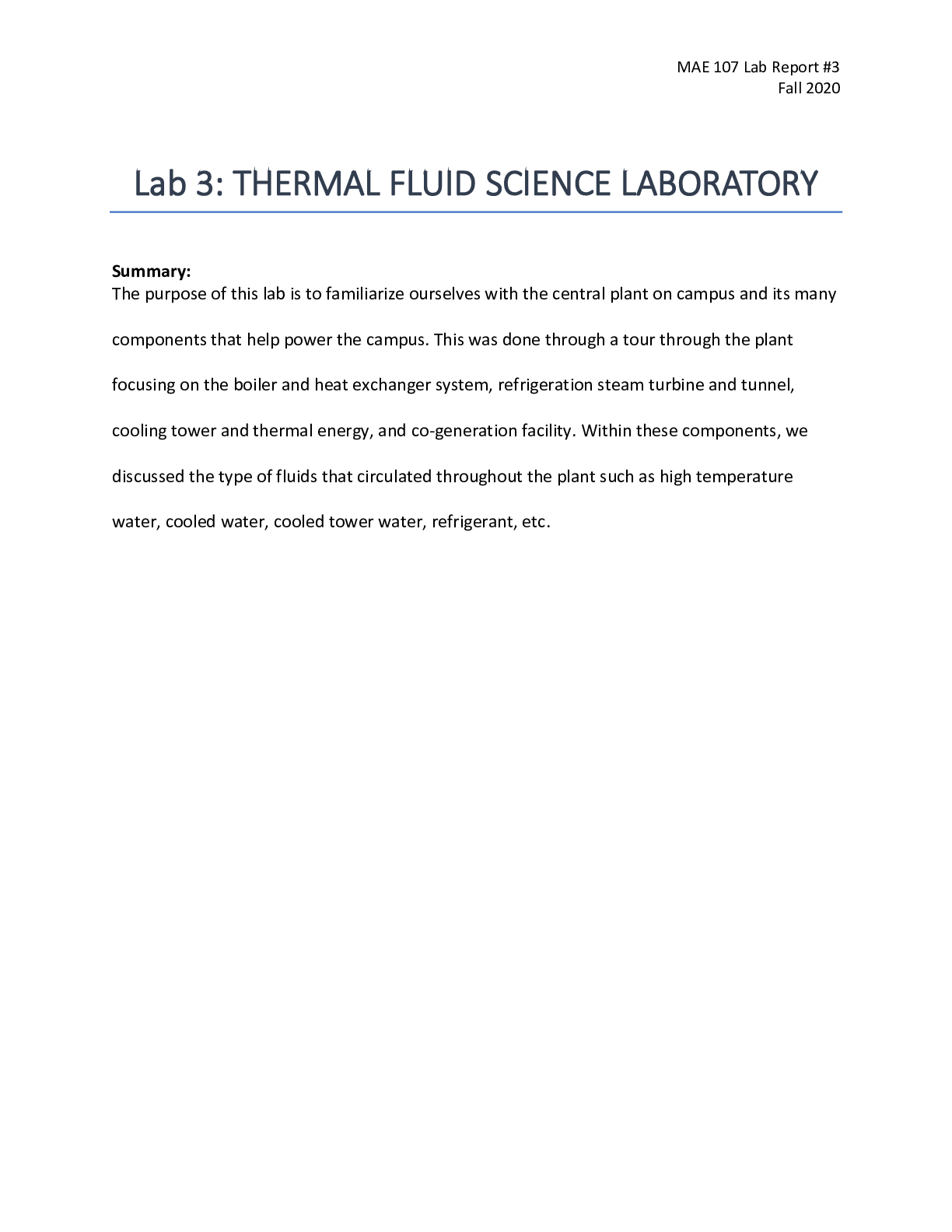Biology > Lab Report > 18SUCMP BIO-124-20103 / Week 8 / Ecology Lab Report. All Correct Answers Provided. (All)
18SUCMP BIO-124-20103 / Week 8 / Ecology Lab Report. All Correct Answers Provided.
Document Content and Description Below
Home / My courses / 18SUCMP BIO-124-20103 / Week 8 / Ecology Lab Report Started on Monday, July 16, 2018, 6:02 PM State Finished Completed on Friday, July 20, 2018, 6:09 PM Time taken 4 days Grad... e 79.50 out of 100.00 Question 1 Match the following terms with their definitions. Ecological niche the role an organism plays in its community ! Habitat where an organism lives ! Resource partitioning the development of two niches to decrease competition between species ! Your answer is . : Ecological niche → the role an organism plays in its community, Habitat → where an organism lives, Resource partitioning → the development of two niches to decrease competition between species http://gmc.mrooms3.net/mod/quiz/review.php?attempt=1788588&cmid=2570777 7/25/18, 7C14 AM Page 1 of 21Question 2 Complete Mark 4.50 out of 4.50 Explain the relationship between the competitive exclusion principle and resource partitioning. Competitive exclusion principle-states that no two species can occupy the same niche at the same time. Competitive for resources does not always exchange lead to the localized extinction of a species. The resource partitioning decreased competition between species. What could have been one niche became two more specialized niches due to species differences in feeding behavior Comment: Question 3 Complete Mark 4.50 out of 4.50 Describe a predator-prey interaction. How does parasitism fit into this type of interaction? A predator is an organism that eats another organism. The prey is the organism which predator eats. Parasitism can be considered a type of predation because one individual obtains nutrients from another. Predation and parasitism are expected to increase the abundance of the predator and parasite at the expense of the abundance of the prey or host. Comment: http://gmc.mrooms3.net/mod/quiz/review.php?attempt=1788588&cmid=2570777 7/25/18, 7C14 AM Page 2 of 21Question 4 Complete Mark 4.50 out of 4.50 Describe the 3 symbiotic relationships and their expected outcomes. Parasitism- Abundance of parasite increases, and abundance of host decreases Commensalism- Abundance of one species increases, and the other is not affected Mutualism- Abundance of both species increases Comment: Question 5 Complete Mark 4.50 out of 4.50 Compare and contrast primary and secondary succession. Primary succession- occurs in areas where no soil is present, such following a volcanic eruption or glacial retreat. Secondary succession- begins in areas where the soil is present. Comment: Question 6 http://gmc.mrooms3.net/mod/quiz/review.php?attempt=1788588&cmid=2570777 7/25/18, 7C14 AM Page 3 of 21Match the following organisms with their descriptions. Decomposers break down dead organic matter ! Scavengers feed on dead remains of plants and animals ! Omnivores feed on both plants and animals ! Carnivores feed on other animals ! Autotrophs use inorganic nutrients and outside energy source as nutrition ! Producers produce their own food ! Heterotrophs consume their own food ! Herbivores feed on plants and algae ! Your answer is . : Decomposers → break down dead organic matter, Scavengers → feed on dead remains of plants and animals, Omnivores → feed on both plants and animals, Carnivores → feed on other animals, Autotrophs → use inorganic nutrients and outside energy source as nutrition, Producers → produce their own food, Heterotrophs → consume their own food, Herbivores → feed on plants and algae Question 7 Complete Mark 4.50 out of 4.50 http://gmc.mrooms3.net/mod/quiz/review.php?attempt=1788588&cmid=2570777 7/25/18, 7C14 AM Page 4 of 21In detail, describe how energy cycles through an ecosystem. Where does it begin? How does it move through? What form is it lost as? Energy is lost from the biosphere but inorganic nutrients are not. They recycle within the ecosystems. Decomposers return inorganic nutrients directly to autotrophs, or they are imported or exported between ecosystems in global cycles. Energy flow begins when producers absorb solar energy, and chemical cycling begins when producers take in inorganic nutrients (food) directly for themselves and indirectly for the other populations of the ecosystem. Energy flows through an ecosystem via photosynthesis because as organic nutrients pass from one component of the ecosystem to another, as when an herbivore eats a plant or carnivore eats an herbivore, a portion of those nutrients is used as an energy source. The rest of the energy dissipates into the environment as heat. Therefore, the vast majority of ecosystems cannot exist without a continual supply of solar energy. Comment: Question 8 Complete Mark 4.50 out of 4.50 What would happen to an ecosystem if the decomposers disappeared? Dead organic matter would accumulate in deep piles, decomposers service the entire biosphere when they recycle nutrients to plants which produce the food they got themselves directly and for all other organisms indirectly. Without decomposers, plants would be completely dependent only on physical processes, such as the release of minerals from rocks, to supply them with inorganic nutrients. Comment: Question 9 http://gmc.mrooms3.net/mod/quiz/review.php?attempt=1788588&cmid=2570777 7/25/18, 7C14 AM Page 5 of 21Question 9 Complete Mark 4.50 out of 4.50 Could there be a food chain without herbivores and carnivores? No, Herbivores and omnivores all provide food for a number of different carnivores. Detrital food web, which begins with detritus. Detritus is food for soil organisms such as earthworms. Earthworms are in turn, eaten by carnivorous invertebrates, and these may be consumed by salamanders or shrews. The members of detrital and grazing food webs are connected. More energy in a forest may be funneling through the detrital food web than through the grazing food web. Comment: Question 10 Complete Mark 4.50 out of 4.50 A large percentage of living species on the Earth live in tropical rain forests of the world. Why are so many organisms able to inhabit the rain forest biome? A biome is a large terrestrial region characterized by a specific type of climate and dominant plant life. There are a variety of terrestrial biomes contributing to the biodiversity on the earth. The tropical rainforests are found at the equator with hot, moist air rises to dump the moisture in the land. These forests have warm temperatures, high humidity, and heavy rainfall daily. The forests are dominated by broadleaf evergreen plants and much of animal life specifically large insects, bats and birds are abundant. Tree climbing animals and decomposers are heavily populated in tropical rain forests. These forests show great biodiversity with suitable climatic conditions for survival of all type of animals. For these reasons, the tropical forests have a great biodiversity on the earth. http://gmc.mrooms3.net/mod/quiz/review.php?attempt=1788588&cmid=2570777 7/25/18, 7C14 AM Page 6 of 21Comment: Question 11 Complete Mark 4.50 out of 4.50 Describe one animal in each biome. Name two characteristics of these animals that show they are adapted to where they live. Tundra - Caribou Caribou is also known as Reindeer. They are migratory animals which migrate to the tundra regions in search of food. The females weigh approx 200 pounds and male around 600 pounds.presence of antlers is seen on both males and females. The food mostly varies with season. In summer, they feed on plants and in winter, feed on moss and lichens present beneath the snow. adaptations: the presence of thick fur and double layer coat acts as an insulating layer in the cold tundra climate.presence of hooves on their feet allows them to dig through mud and snow. Taiga: moose : moose belongs to the deer family. males weigh 300-700 kg and females 200-500 kg, They feed on land and water plants. Males have palmate antlers, They prefer to live solitarily.T hey are slow moving but can move fast when angry. adaptations : pthe resence of thick fur and coat keeps it warm in the taiga climate.presence of long, strong legs with hooves to penetrate the snow and ability to eat pine needles and sprice needles allows it to survive in tthe aiga. Temperate forests - black bear black bear as the name suggests are not always black.T hey may be silver color also..they have large heads and ears in comparision to their body.T hey have strong legs and can move or run very fast.A re good swimmers as well.P resence of clwas in legs hepls during food feeding.f eed both on animals and plants. adaptations : undergo hibernation in temperate forests during cold.f ood eaten in summer is generally stored as fat under the skin. Tropical forests : sloth http://gmc.mrooms3.net/mod/quiz/review.php?attempt=1788588&cmid=2570777 7/25/18, 7C14 AM Page 7 of 21Tropical forests : sloth sloths are about the size of dogs and may ne 2 or 3 toed.Their head is short and flat.T hey are found hanging upside down from tress by the hepl of hooked claws in the legs. Feed mostly on fruits and flowers. adaptations : the presence of thick dense coats prevent from the rains. Camouflage helps to prevent from pradators. Green algae grows on its fur and the green clor mixes with that of trees preventing from the attack of predators.2 toed sloths can vary thier body temperature as per climatic conditions. Grassland : bison Bison also known as buffalo. They are very heavy animals and can weigh uoto a ton.6- 6.5 feet tall and 10-12,5 feet long, It has an hump through which it can dig through the snow. they feed mainly on plants and grasses. adaptations : presence of flat teeth at te top of the mouth and digestive system is adapted to feed on grasses. Hooves in legs hepls them move fast and woollen coats on body prevent from extreme cold. Deser -snakes Desert snakes: They have scales on their body to protect them, They can be blown through the sand to some distance. Have a narrow head and small eyes. Breathing is aided through lower jaws, adaptations : they bury themselves inthe sand to keep them cold and have the characteristic of camouflage as a result of which it ecsapes the sand predators. Comment: Question 12 Complete Mark 4.50 out of 4.50 Discuss how air currents play a role in rainfall. Air currents have a direct effect on rainfall Because Earth rotates on its axis daily and its surface consists of continents and oceans, an overall flow of warm and cold air currents are modified into three large circulation cells in each hemisphere. a) At the equator, the sun heats the air and evaporates water. Warm, moist air rises, cools and loses most of its http://gmc.mrooms3.net/mod/quiz/review.php?attempt=1788588&cmid=2570777 7/25/18, 7C14 AM Page 8 of 21moisture as rain. The rising air flows toward the poles, but at about 30 degrees north and south latitude, it sinks toward the Earth’s surface and reheats. This creates very dry zones, and the great deserts of Earth occur at these latitudes. At about 60 degrees north and south latitude, the air rises and cool producing additional zones of high rainfall, supporting the great forests of the temperate zone. The spinning of Earth causes a curving pattern of the winds and ocean currents.Periods of calm called the doldrums occur at the equator. At about 30 degrees latitude below and above the equator, the trade winds blow. Comment: Question 13 Complete Mark 4.50 out of 4.50 How do topography and nearby bodies of water affect rainfall? Topography refers to the surface features of the land. The temperature of the oceans is more stable than that of landmasses. Ocean water gains or loses heat slowly than terres environments do. This gives coasts a unique weather pattern that is not observed inland.During the day, the land warms quickly than the ocean, and air above the land rises. Then a cool sea breeze blow in from the ocean. At night, the reverse happens; the breeze blows from the land toward the ocean. Mountains are natural barriers to the movement of wind. They are colder than surrounding flatlands because the temperature decreases with elevation. As a result, there may be a tropical climate at the bottom of the mountain and snow on top. Mountains are wetter on the windward side because of this temperature differential. Winds carrying moist air rise when they reach the mountain and cool as they rise higher. Cold air cannot hold as much water as warm air, and precipitation is the usual result. However, the leeward side of the mountain tends to be drier because the wind loses all of its moisture on the windward side, and the air compresses and warms as it works its way down the mountain. Topography affects temperatur, therefor; mountains affect climate just as latitude does. Mountains in the path of winds affect rainfall. A rain shadow occurs on the leeward side of the mountain. Atmospheric circulations between the ocean and the landmasses indl regional climate condition, accounting for why Asia has a monsoon climat. http://gmc.mrooms3.net/mod/quiz/review.php?attempt=1788588&cmid=2570777 7/25/18, 7C14 AM Page 9 of 21regional climate condition, accounting for why Asia has a monsoon climat. Comment: Question 14 Based on the assumptions described in the introduction why might the mark and recapture method of population estimation be more accurate in the lake setting we are studying than in a stream or river? Select one: a. it is easier to catch fish in a lake than in a stream or river b. it is harder to randomize selection of fishing locations in a stream or river because they are uniform environments, whereas a lake is a more varied environment c. the tags get caught on rocks in rivers or streams and kill the fish which messes up the population estimate; this happens less in lakes d. a lake is a fairly stable environment, whereas rivers and streams are in motion and so the population is much more dynamic ! : a lake is a fairly stable environment, whereas rivers and streams are in motion and so the population is much more dynamic Question 15 Complete Mark 1.50 out of 3.00 In the Background, we discussed the importance of selecting appropriate collecting http://gmc.mrooms3.net/mod/quiz/review.php?attempt=1788588&cmid=2570777 7/25/18, 7C14 AM Page 10 of 21In the Background, we discussed the importance of selecting appropriate collecting locations. Now consider each of the collecting locations of this lab, mapped below. What is one characteristic of each location that makes samples collected there distinct? it is at an intermediate depth between the shore and the center of the lake, but it is close to the shore on several sides since it is in a triangular region of the lake Comment: Locations 1 and 2 are at intermediate depths between the shore and the center of the lake, but location 1 is closer to the shore on several sides, since its in a more triangular region of the lake, while location 2 is only close to the shore on one side. Location 3 is at the center of the lake so it has the deepest depth. Location 4 is very close to the shore and in a more sheltered region of the lake since its in a region thats juts off the lake and is more closely surrounded by the shore. Location 5 includes the shore and is also in a more sheltered region although, not as sheltered as the one in location 4. Question 16 In the introduction, we discussed the importance of selecting appropriate collecting locations. What is one characteristic of location 1 that might make the sample you collected there distinct from the others? http://gmc.mrooms3.net/mod/quiz/review.php?attempt=1788588&cmid=2570777 7/25/18, 7C14 AM Page 11 of 21collected there distinct from the others? Select one: a. it is at the center of the lake and has the greatest depth b. it is at an intermediate depth between the shore and the center of the lake, but it is close to the shore on several sides since it is in a triangular region of the lake ! c. since it is the farthest away from any of the other locations, it should have the most distinct selection of fish d. it is at an intermediate depth between the shore and the center of the lake, but it is only close to the shore on one side : it is at an intermediate depth between the shore and the center of the lake, but it is close to the shore on several sides since it is in a triangular region of the lake Question 17 In Mark 0.00 out of 3.00 What was the range of the bluegills’ length? To find this value, subtract the least value from the greatest value. http://gmc.mrooms3.net/mod/quiz/review.php?attempt=1788588&cmid=2570777 7/25/18, 7C14 AM Page 12 of 21from the greatest value. Answer: 11.89 cm " : 12 cm Question 18 In Mark 0.00 out of 3.00 What was the range of the bluegills’ mass? Answer: 277.20 g " : 280 g Question 19 Which of the following could account for the differences between the range of length and the range of mass that you observed? Select one: a. As they mature, there is no connection between the length the bluegills grow and the mass they gain. Therefore, there is no way to compare the ranges of the http://gmc.mrooms3.net/mod/quiz/review.php?attempt=1788588&cmid=2570777 7/25/18, 7C14 AM Page 13 of 21and the mass they gain. Therefore, there is no way to compare the ranges of the length and mass. b. The length the bluegills grow is proportional to the mass they gain as they mature. Therefore, the ratio of mass to length stays the same. c. The bluegills gain much more mass as they mature, compared to their gain in length. The ratio of mass to length increases. ! d. As the bluegills grow, they gain more in length compared to their gain in mass. Therefore, the ratio of mass to length decreases. : The bluegills gain much more mass as they mature, compared to their gain in length. The ratio of mass to length increases. Question 20 In Mark 0.00 out of 3.00 For part 2, Calculate your population estimate (N) using the equation: N = M (n ÷ r) where n = total number of fish in the sample (100) r = number of marked fish in the sample M = total number of marked fish in population (100) Answer: N=M(n/r)= 100/10=10x100= 1000 fish in population " : 1000 Question 21 http://gmc.mrooms3.net/mod/quiz/review.php?attempt=1788588&cmid=2570777 7/25/18, 7C14 AM Page 14 of 21 Why was it important that we waited a year to perform our second population estimate? Select one: a. the bass hibernate in the spring and so you will not distort the sample by accidentally catching bass while trying to catch bluegills b. the lake freezes over during the winter and it is difficult to capture the fish c. there is more food in the spring so the bluegills are fatter and easier to catch d. the bluegills will be in the same stage of their life cycle as in the first population estimate and any changes in population size will not result from changes in the life cycle ! : the bluegills will be in the same stage of their life cycle as in the first population estimate and any changes in population size will not result from changes in the life cycle Question 22 In Mark 0.00 out of 3.00 After the predator was introduced and a year had passed, what was the range of the bluegills’ length? Remember it is the difference between the greatest and least value. Answer: 11.80 cm " : 12 cm http://gmc.mrooms3.net/mod/quiz/review.php?attempt=1788588&cmid=2570777 7/25/18, 7C14 AM Page 15 of 21Question 23 In Mark 0.00 out of 3.00 After the predator was introduced and a year had passed, what was the range of the bluegills’ mass? Answer: 271.33 g " : 280 g Question 24 Complete Mark 4.50 out of 4.50 Was there a change in range value from the previous year? What can you conclude from the change or lack of change in the ranges? The range of the Bluegills' length decreased by a little over .9 cm while the range in mass more than doubled from the previous year. From these major changes, I can conclude that the Bluegills are becoming closer in length around the pond but they are getting different amounts of food due to the leap in the range of the mass Comment: Question 25 http://gmc.mrooms3.net/mod/quiz/review.php?attempt=1788588&cmid=2570777 7/25/18, 7C14 AM Page 16 of 21Question 25 In Mark 0.00 out of 1.00 Which of the following is a reason why predation might increase the bluegill's mass to length ratio? Select one: a. overall the bass catch younger, weaker and so smaller fish, thereby creating a population of older larger fish " b. in order to avoid the bass the bluegills move less which increases the mass to length ratio c. the bluegills have to swim a lot to avoid the bass and so their muscle mass increases d. the bluegills eat a lot to raise their energy reserves in case the bass prevent them from reaching their food : in order to avoid the bass the bluegills move less which increases the mass to length ratio Question 26 Which of the following is a reason why predation might increase the bluegill's mass to length ratio? Select one: a. overall the bass catch younger, weaker and so smaller fish, thereby creating a population of older larger fish b. the bluegills have to swim a lot to avoid the bass and so their muscle mass increases http://gmc.mrooms3.net/mod/quiz/review.php?attempt=1788588&cmid=2570777 7/25/18, 7C14 AM Page 17 of 21c. the bluegills eat a lot to raise their energy reserves in case the bass prevent them from reaching their food d. the mass increases relative to the length so that the bluegills are too wide to be a comfortable mouthful for the bass ! : the mass increases relative to the length so that the bluegills are too wide to be a comfortable mouthful for the bass Question 27 In Mark 0.00 out of 3.00 For part 3, calculate your population estimate using the same equation from #20. Answer: 770 " : 780 Question 28 Complete Mark 4.50 out of 4.50 How does your population estimate compare to your estimate from Part 2? Does the change fit in with our expectations discussed in the Background? If not, why do you think the bass effected the bluegill population in this way? The population estimate is about 230 fish less in the recapture http://gmc.mrooms3.net/mod/quiz/review.php?attempt=1788588&cmid=2570777 7/25/18, 7C14 AM Page 18 of 21than in Part 2. This fits with the expectations discussed in the Background because a predator was added into the lake and the population was affected by it. Comment: Question 29 We used new tags for the population estimate a year later. If we assume the tags stay on well over the year, what changes the proportion of the old marked tags in the population and make the use of new tags more accurate? (Hint: look back at the assumptions made by the mark and recapture method). Select one: a. we cannot assume the tags would stay on longer than six months, so we need new tags for the fish b. as tagged fish die and larvae that were not tagged reach maturity the proportion of tagged fish changes ! c. random loss of the tags might be sufficiently large to change the proportion of tagged fish d. the fish might eat the tags : as tagged fish die and larvae that were not tagged reach maturity the proportion of tagged fish changes Question 30 http://gmc.mrooms3.net/mod/quiz/review.php?attempt=1788588&cmid=2570777 7/25/18, 7C14 AM Page 19 of 21Despite problems with tagging organisms over extended periods of time scientists do study population for extended periods. Which of the following is not a case where a scientist would track individuals for an extended period? Select one: a. studying members of an endangered species to monitor longevity or reproduction. b. studying how fish evade motor boats ! c. studying the effect of contraceptives for population management of "pest species", deer for example d. studying the long-term effects of a pollutant : studying how fish evade motor boats Question 31 Which of the following is NOT a logical pairing of another environmental factor that will possibly affect the bluegill population with how that factor would affect it? Select one: a. acid rain increases the acidity of the lake and so helps break down the bluegills' food and increases the population ! b. the extinction of the bluegill's competitor increases the bluegills food source thereby increasing the bluegill population c. soil erodes into the lake and changes the bottom habitat where the bluegill spawn thereby decreasing the population d. pollutants poison the bluegills' source of food thereby decreasing the population http://gmc.mrooms3.net/mod/quiz/review.php?attempt=1788588&cmid=2570777 7/25/18, 7C14 AM Page 20 of 21: acid rain increases the acidity of the lake and so helps break down the bluegills' food and increases the population Question 32 Complete Mark 9.50 out of 9.50 Completion of the virtual lab. 100% must be completed for full credit. Comment: ◀ Major Ecosystems of the Biosphere Quiz Jump to... Conservation Biology Study Guide ▶ Page 21 of 21 [Show More]
Last updated: 1 year ago
Preview 1 out of 21 pages

Reviews( 0 )
Document information
Connected school, study & course
About the document
Uploaded On
Nov 27, 2020
Number of pages
21
Written in
Additional information
This document has been written for:
Uploaded
Nov 27, 2020
Downloads
0
Views
54



 (1).png)

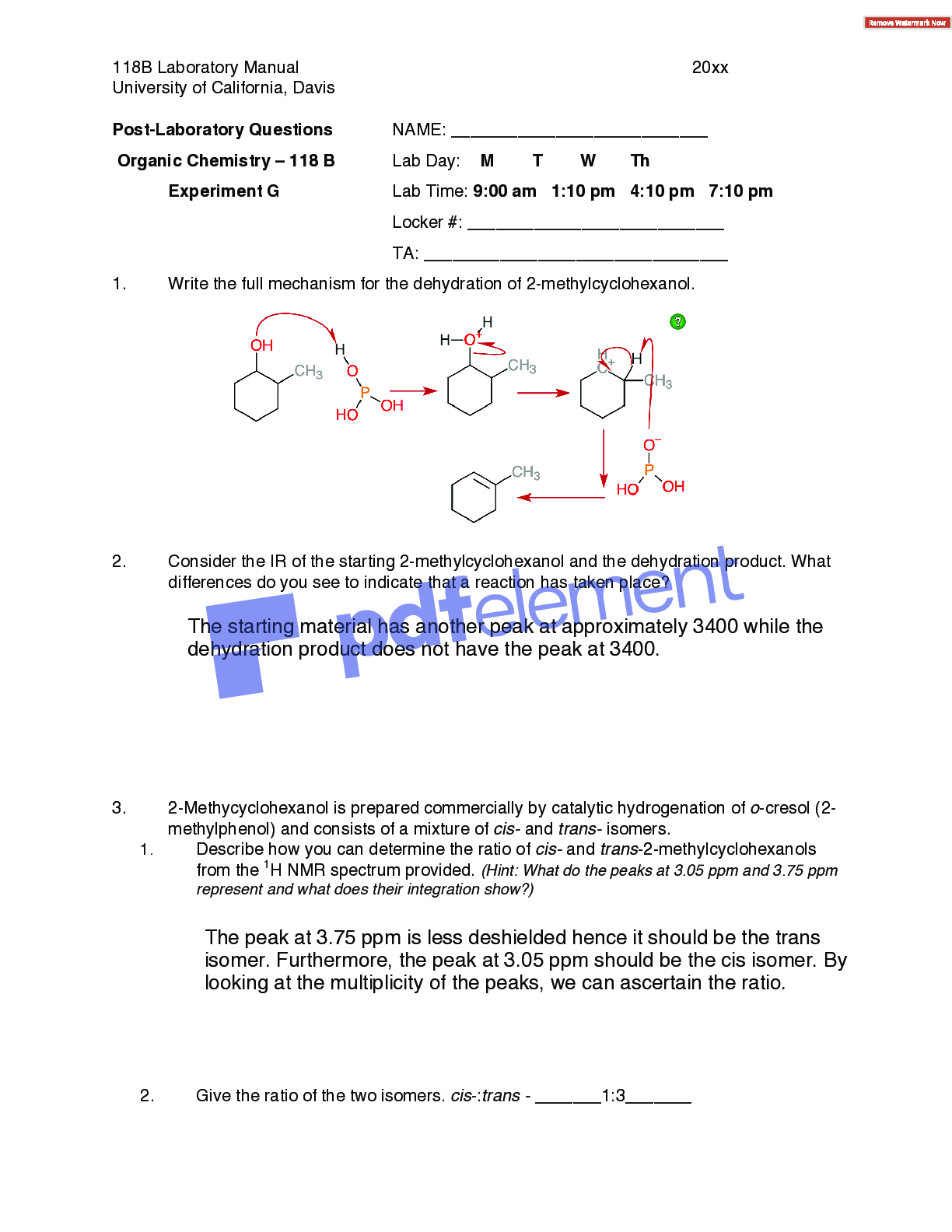
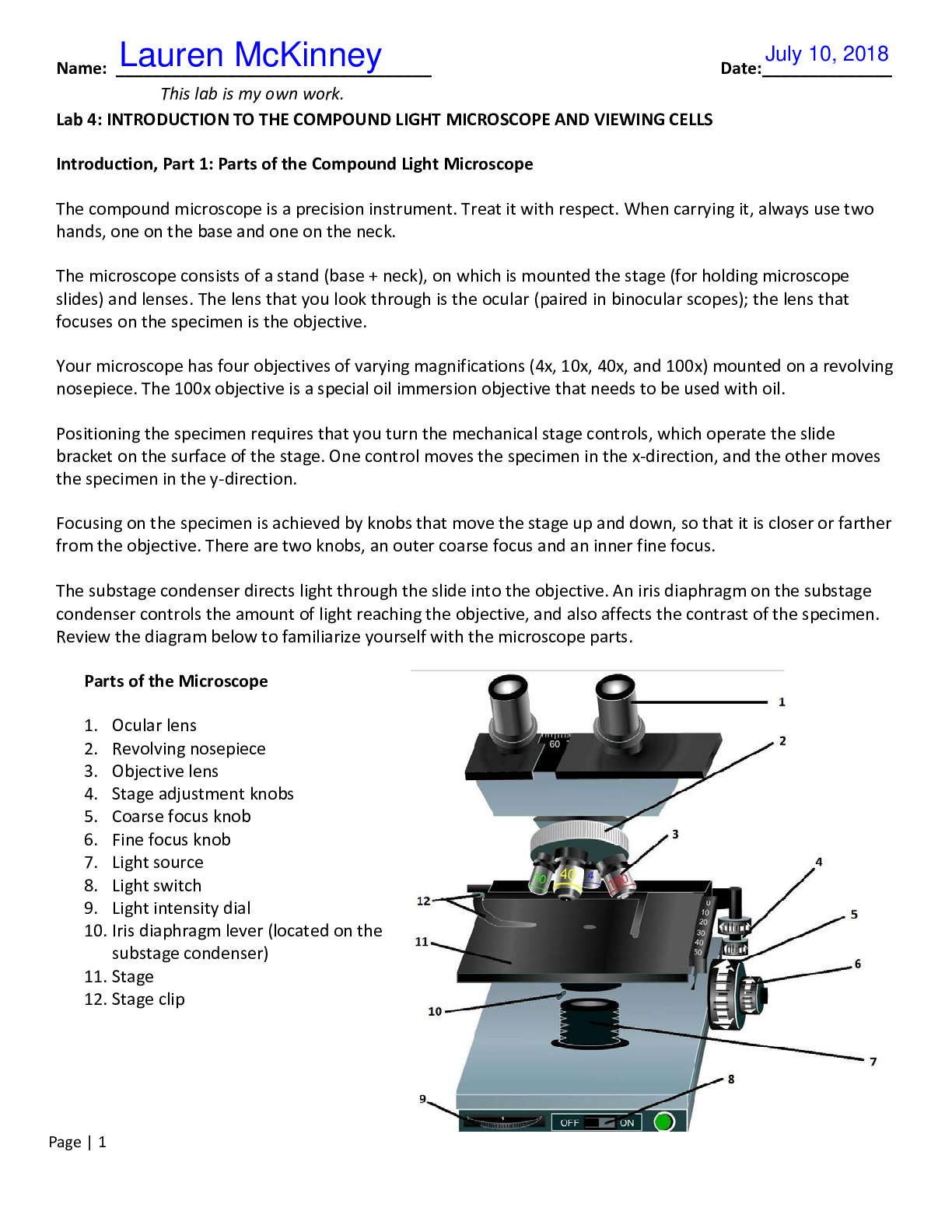
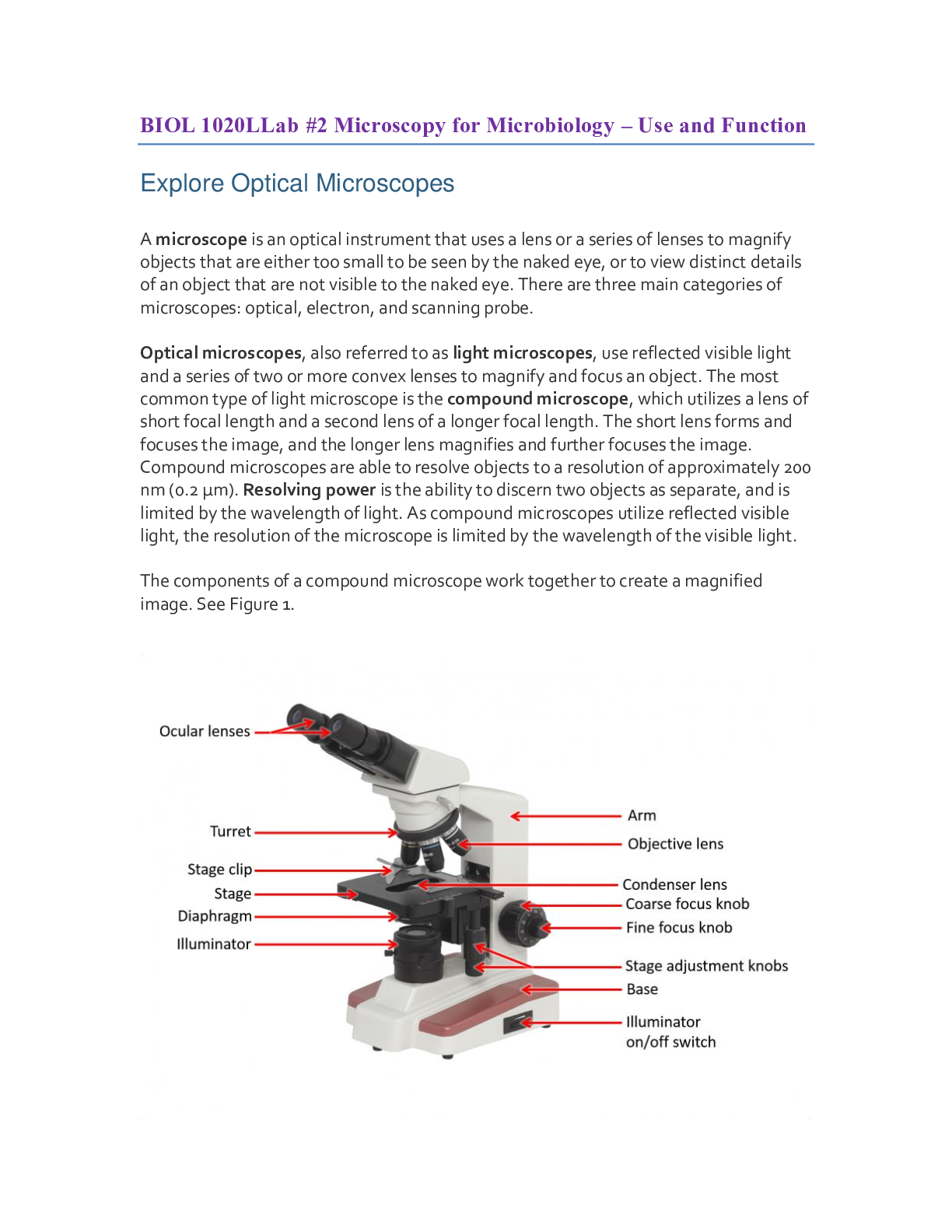



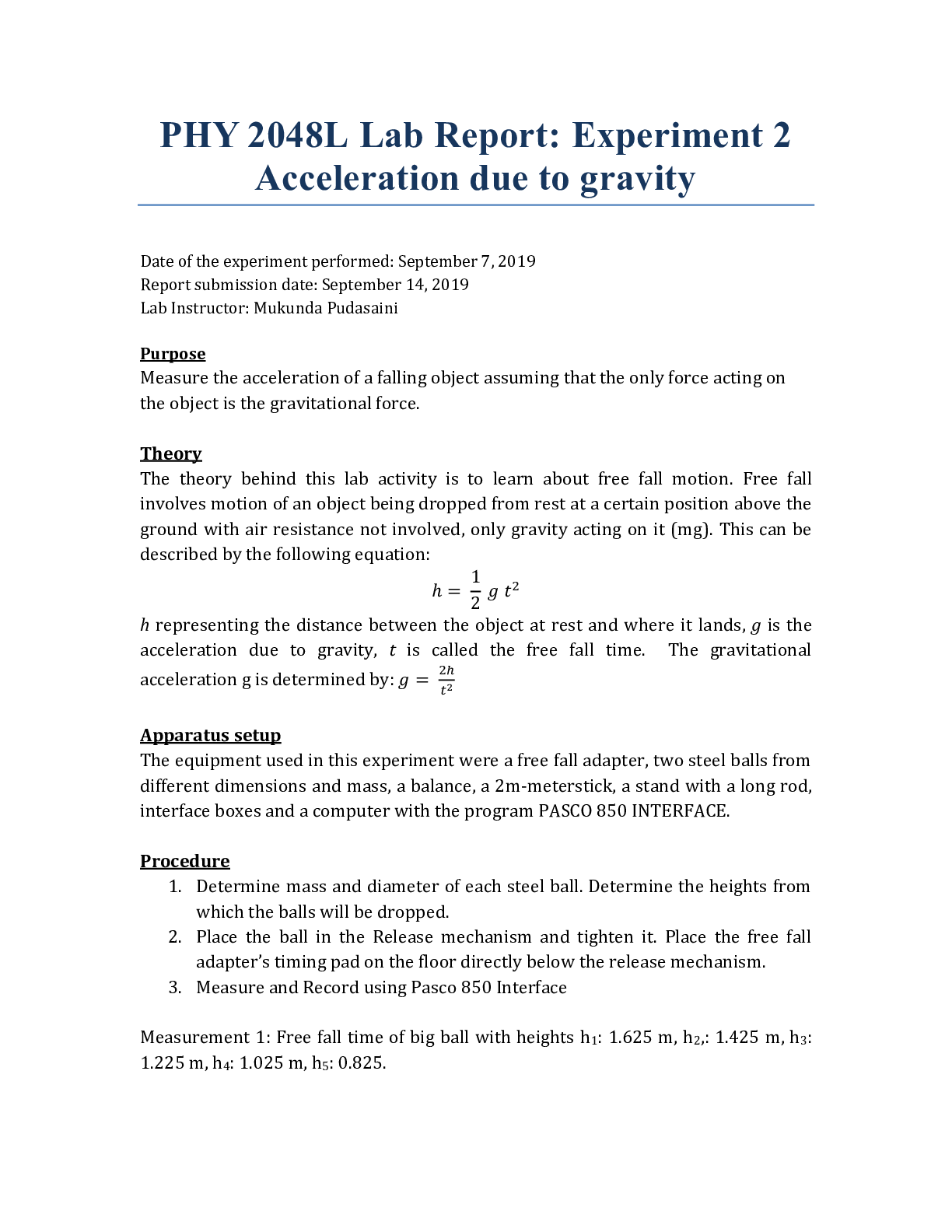


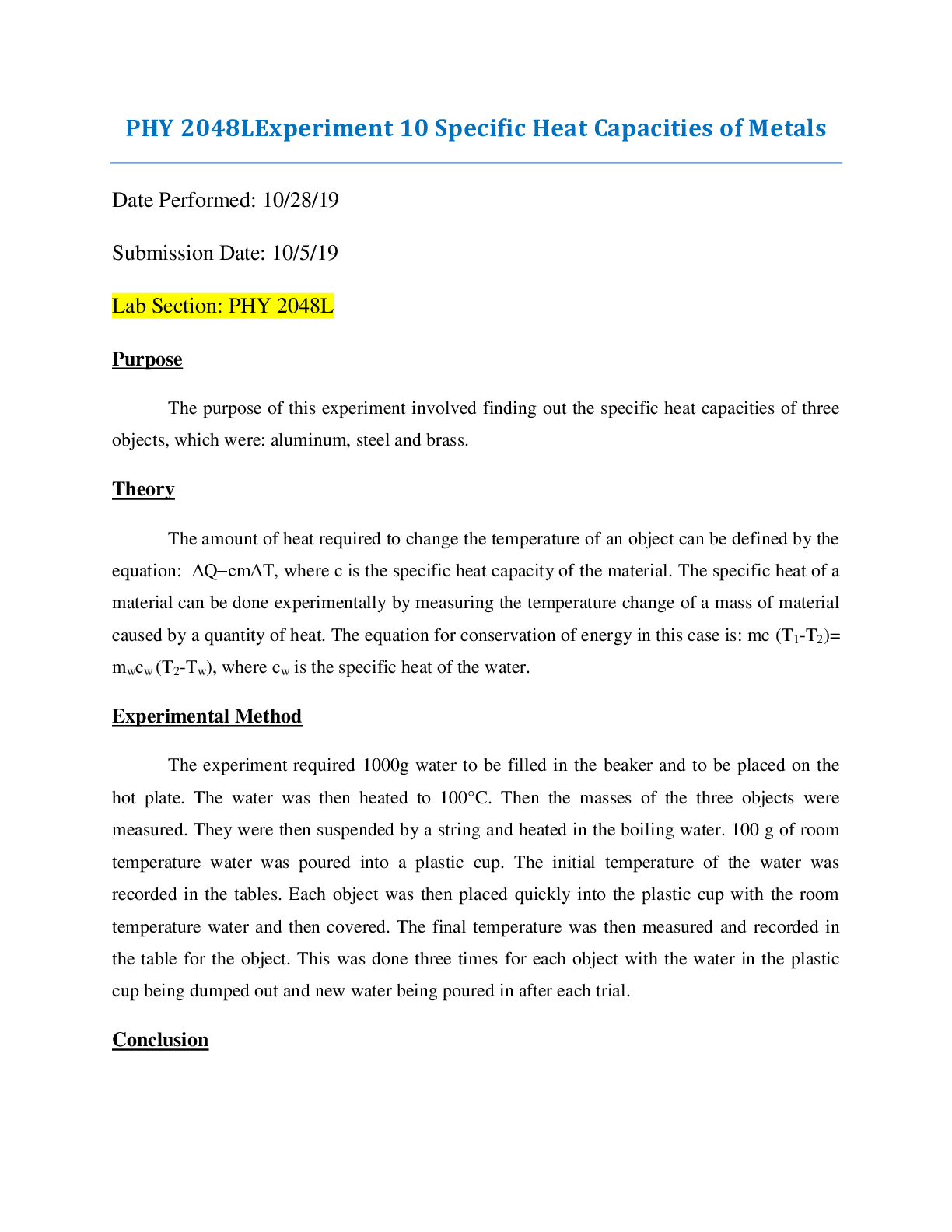
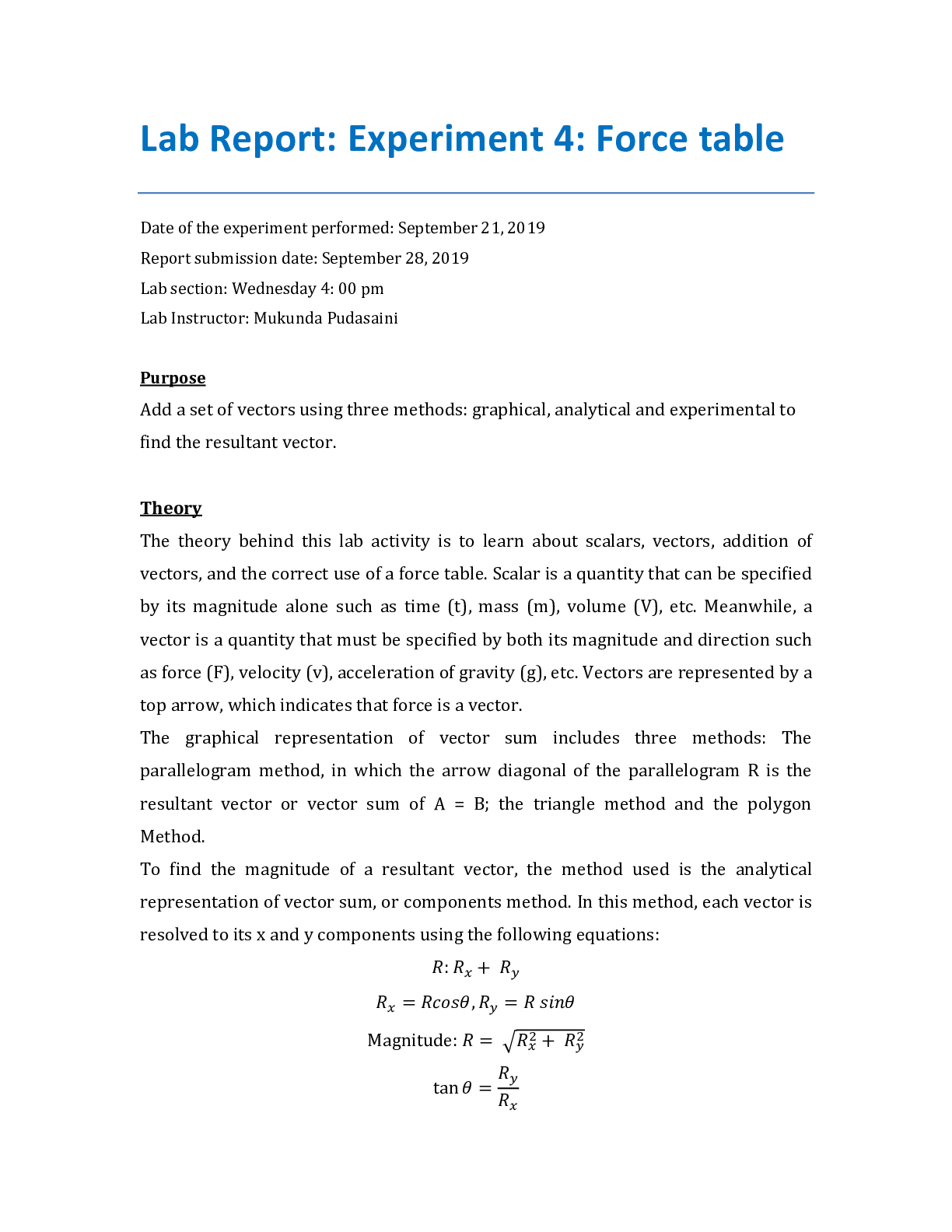
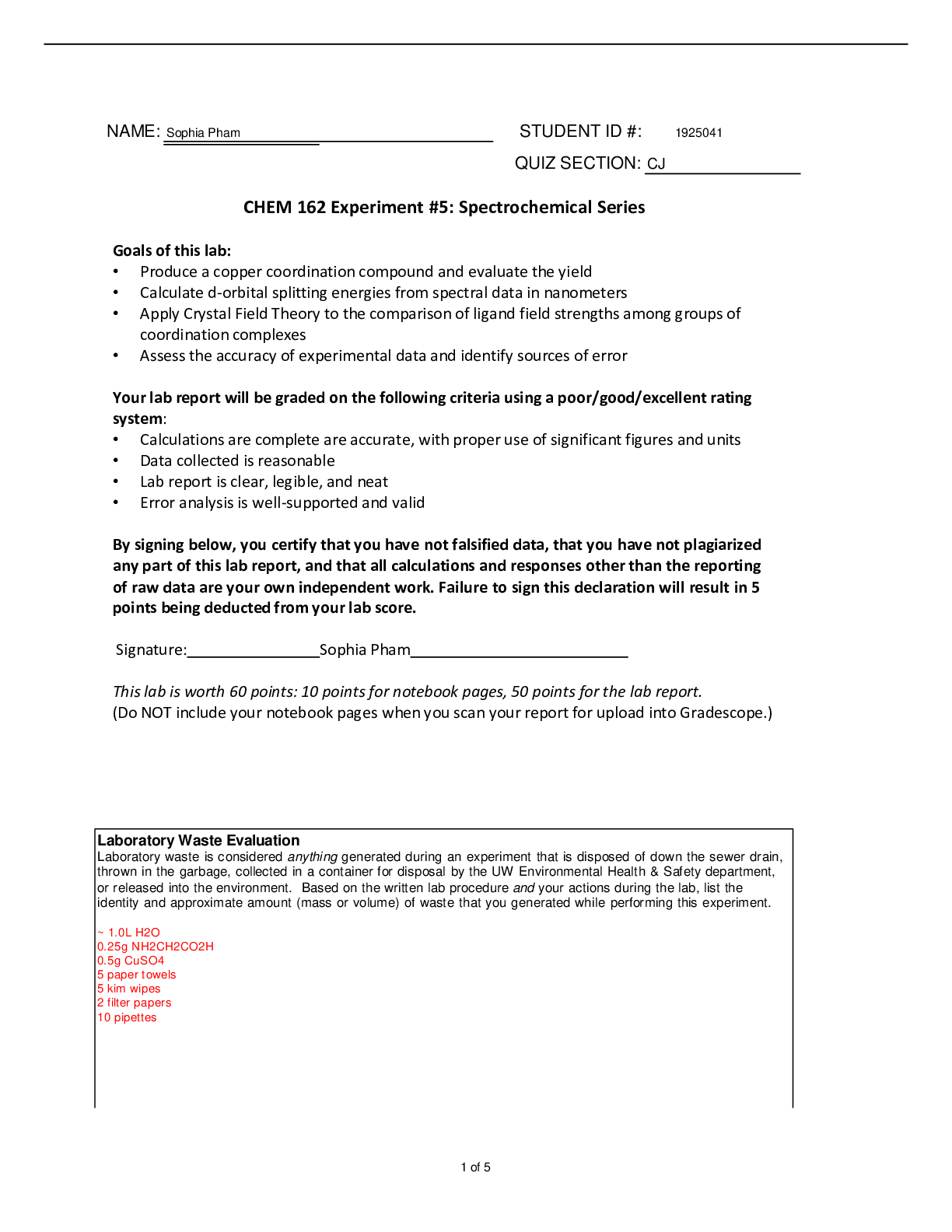




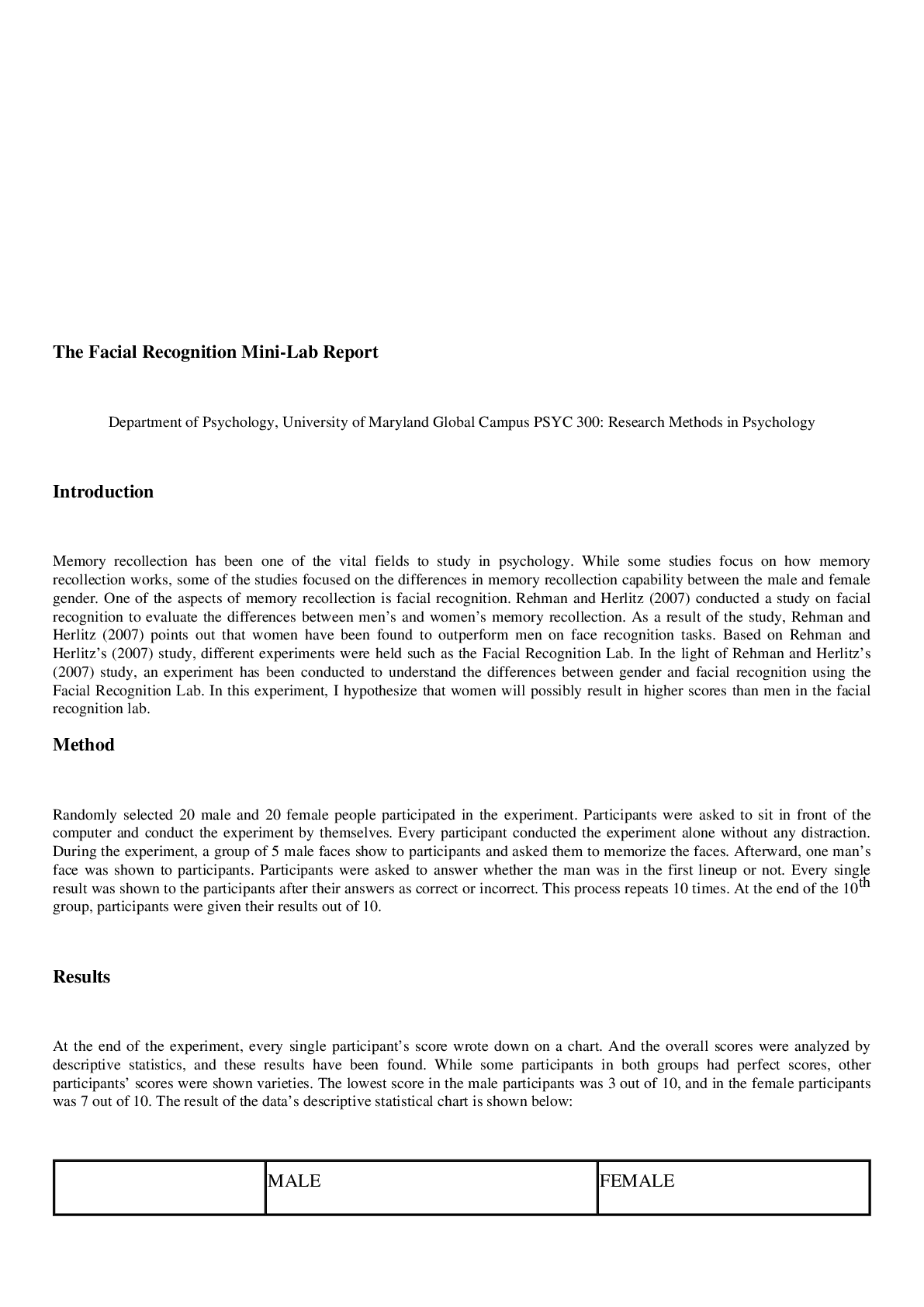
 (1).png)

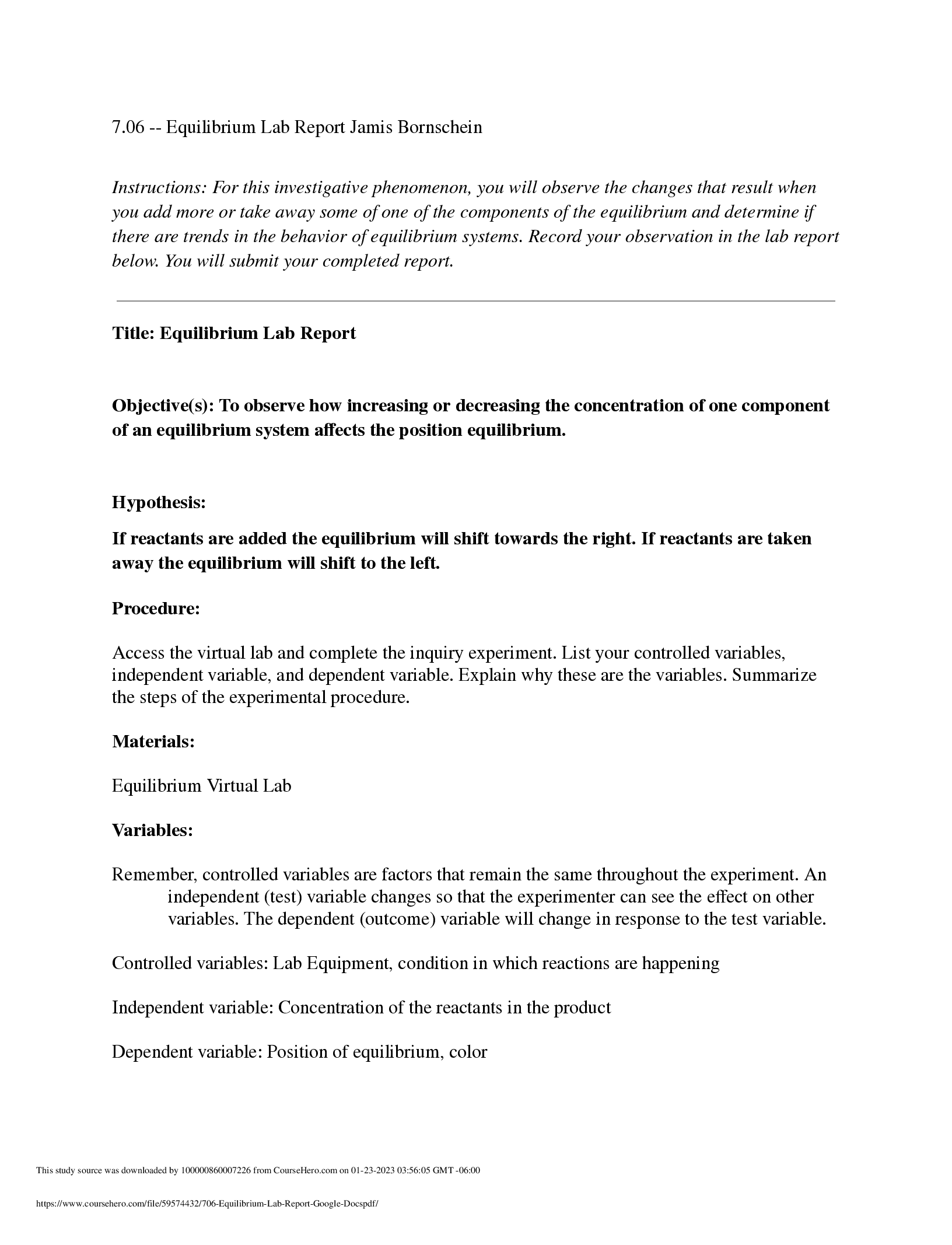

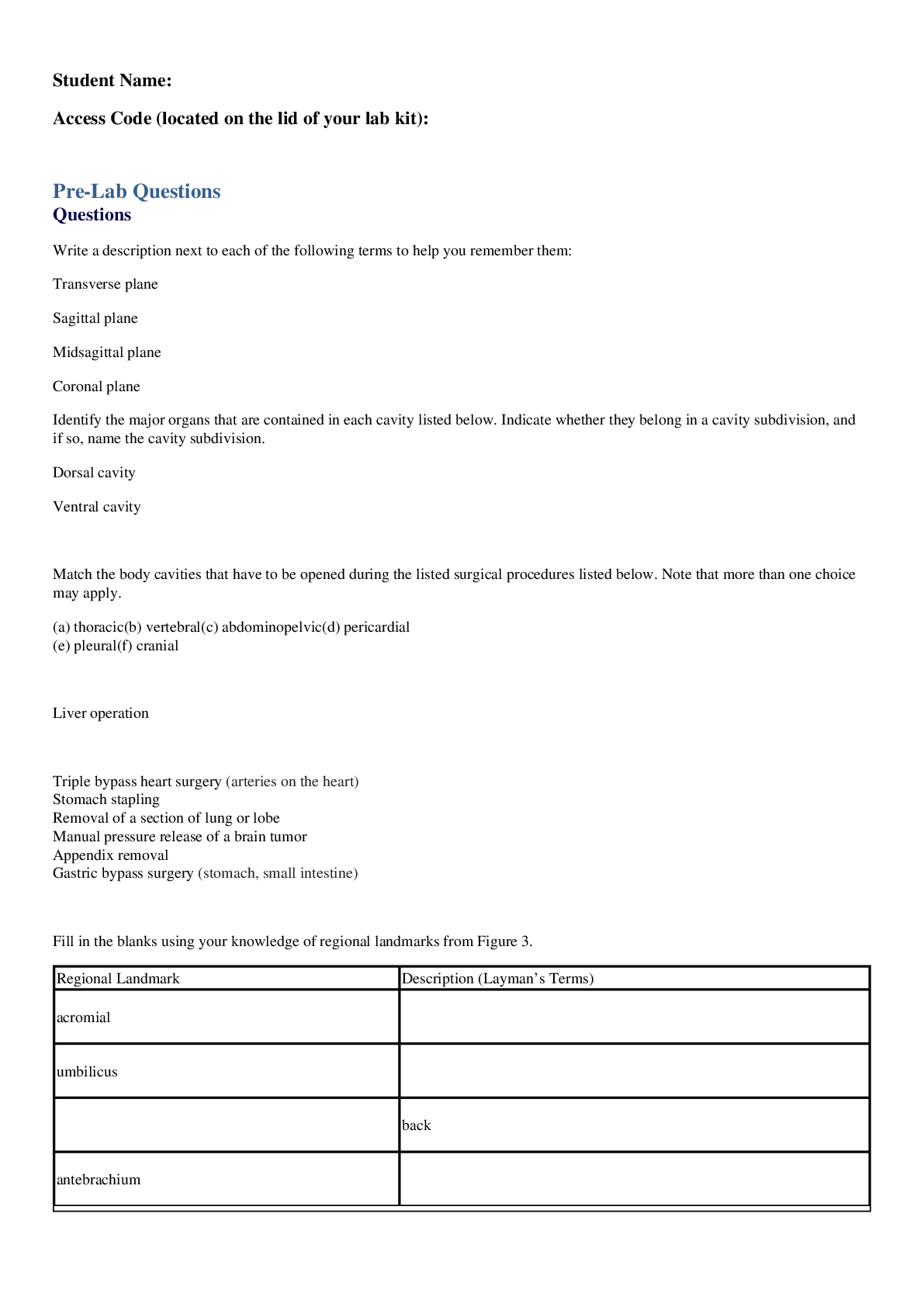

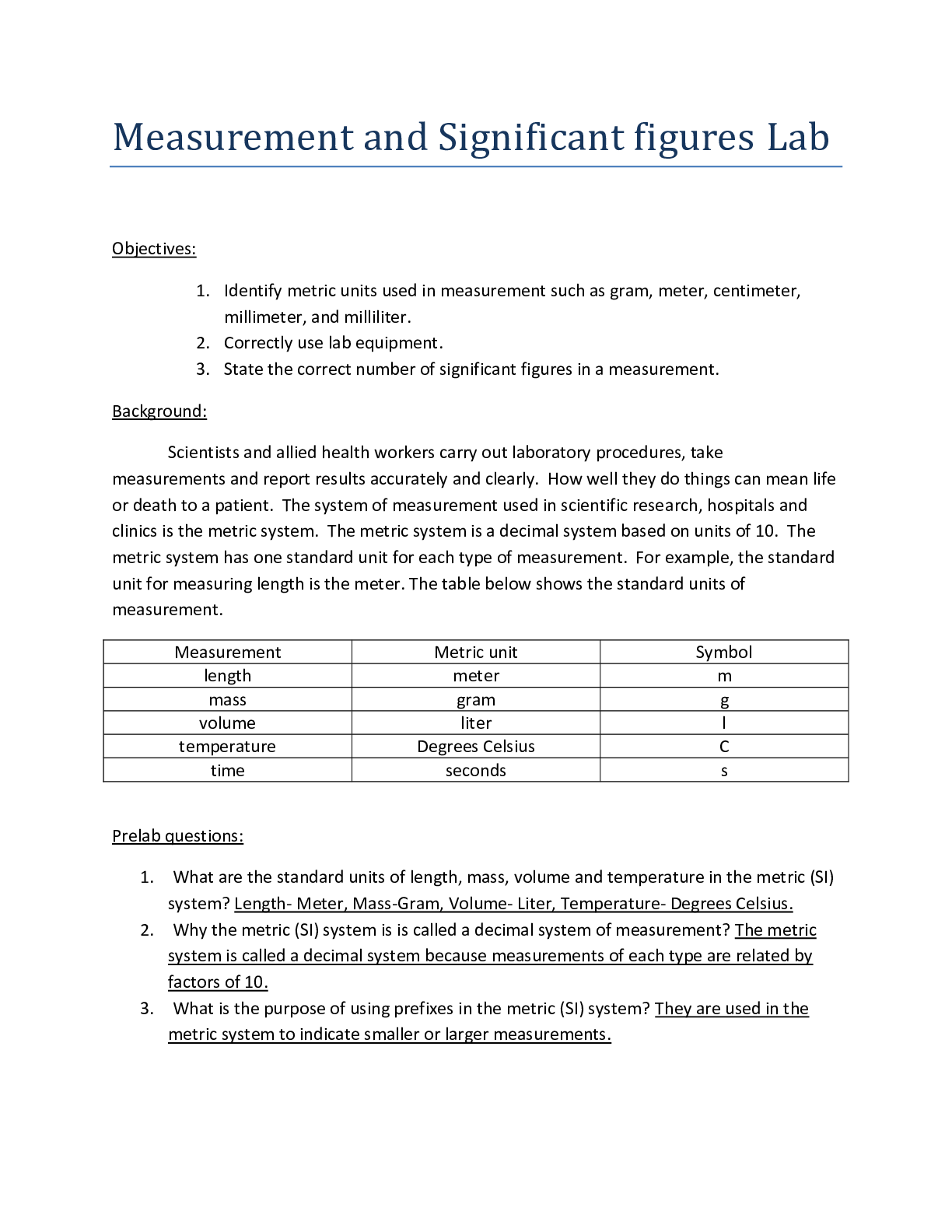
.png)


